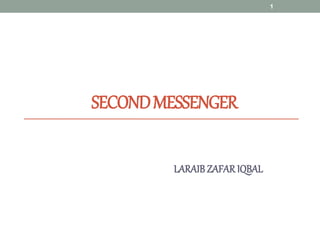
Second messenger.pptx
- 2. Contents: • Introduction • Mechanism of second messenger • General characteristics • Types • cAMPs • cGMPs • PI3P • Ca+ • Conclusion • References 2
- 3. INTRODUCTION: • Second messengers are intracellular signaling molecules released by the cell to trigger physiological changes such as proliferation, differentiation, migration, survival, and apoptosis. • Secondary messengers are therefore one of the initiating components of intracellular signal transduction cascades. 3
- 4. Mechanism of second messenger • Electrical and biochemical signals are stimulated by the second messenger mechanism. • These signals are stable long- lasting and specialized for memory. The human brain uses calcium and adenosine monophosphate for successfully transfer the synaptic stimulus which is stored in the brain. • The first messenger is no need for entering the cell because of the fast response with neurons stimulation. • These are amplifiers for the primary as well as multiple signaling pathways at different places of the cell. 4
- 6. 6
- 7. Cyclic AMP 7
- 8. Cyclic GMP 8
- 11. Di acyalglycrol • Diaclyglysrol stimulate protein kinase C activity by increasing the affinity of enzyme for calcium ions. • Protein kinase C phosphorylates serine and threonine residues in target proteins. 11
- 12. Calcium ion • Act as second messenger in many pathway • First bind to an effector molecule • Secondly bind to calmodiulin protein 12
- 13. Nitric oxide • Nitric oxide also known as secondary messenger. • Arginine and oxygen formed NO • Activates the guanylyl cyclase • High concentrations 13
- 14. Conclusion • The second messenger plays a vital role in cell signaling of intracellular membranes. • These transduction pathways allow responding to environmental messages. • These are creating relation communication and interaction with other cells. • In which cyclic AMP, cyclic GMP, nitric oxide and calcium which performs special function these activate the protein receptors which transfer the message. • It shows transduction in the cell membrane and cytoplasm. Second messenger coupled as downstream bind with first messenger and response to their need. • So these are work as amplifiers in the physical and chemicals response of the body. • These play a vital role in phosphorylation 14
- 15. References • https://www.youtube.com/watch?v=PzA5Z3DXfrQ • https://www.youtube.com/watch?v=of-tVFypQ_o • https://en.wikipedia.org/wiki/Second_messenger_system • Kodis EJ, Smindak RJ, Kefauver JM, Heffner DL, Aschenbach KL, Brennan ER, Chan K, Gamage KK, Lambeth PS, Lawler JR, Sikora AK (May 2001). • "First Messengers". eLS. Chichester: John Wiley & Sons Ltd. doi:10.1002/9780470015902.a0024167. ISBN 978- 0470016176. Yoshida Y, Imai S (June 1997). "Structure and function of inositol 1,4,5-trisphosphate receptor". Japanese Journal of Pharmacology. 74(2): 125– 37. doi:10.1254/jjp.74.125. PMID 9243320. • ^ Purves D, Augustine GL, Fitzpatrick D, Katz LC, LaMantia AS, McNamara JO, Williams SM, eds. (2001). • "Chapter 8: Intracellular Signal Transduction: Second Messengers". Neuroscience (2nd ed.). Sinauer Associates. ISBN 978-0-87893-7 15